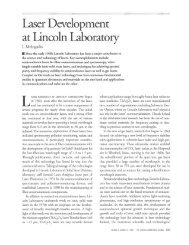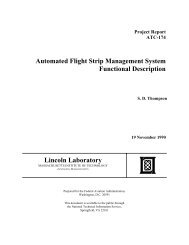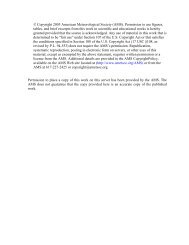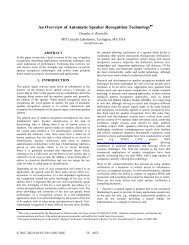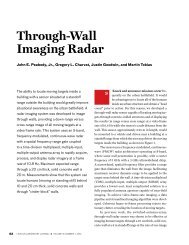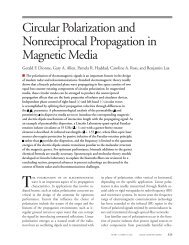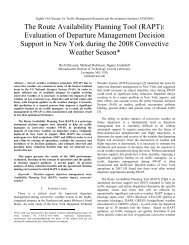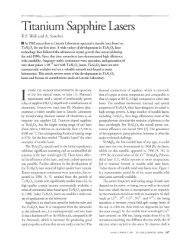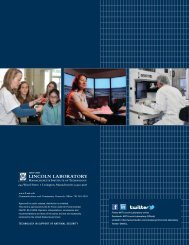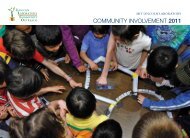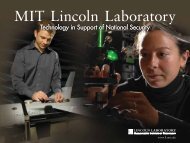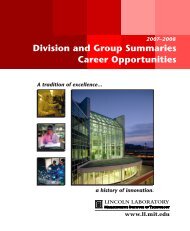2011 MIT Lincoln Laboratory Facts
2011 MIT Lincoln Laboratory Facts
2011 MIT Lincoln Laboratory Facts
Create successful ePaper yourself
Turn your PDF publications into a flip-book with our unique Google optimized e-Paper software.
<strong>2011</strong><br />
<strong>MIT</strong> LINCOLN LABORATORY<br />
FACTS<br />
www.ll.mit.edu
© March <strong>2011</strong><br />
<strong>MIT</strong> <strong>Lincoln</strong> <strong>Laboratory</strong> <strong>Facts</strong> is published by <strong>MIT</strong> <strong>Lincoln</strong> <strong>Laboratory</strong> and prepared<br />
by the <strong>Lincoln</strong> <strong>Laboratory</strong> Communications and Community Outreach Office.<br />
Comments and requests may be sent to llnews@ll.mit.edu.<br />
<strong>MIT</strong> <strong>Lincoln</strong> <strong>Laboratory</strong>’s fundamental mission is to apply science and advanced<br />
technology to critical problems of national security. To assure excellence in the<br />
fulfillment of this mission, the <strong>Laboratory</strong> is committed to fostering an environment<br />
that embraces and leverages diversity of thought, culture, and experience.<br />
The work described in this document is performed under the prime contract<br />
with the U.S. Air Force, FA8721-05-C-0002.
<strong>MIT</strong> LINCOLN LABORATORY<br />
<strong>2011</strong> FACTS<br />
244 Wood Street<br />
Lexington, MA 02420<br />
781-981-5500<br />
www.ll.mit.edu
Quick <strong>Facts</strong><br />
<strong>MIT</strong> <strong>Lincoln</strong> <strong>Laboratory</strong> is a Department of Defense<br />
federally funded research and development center.<br />
Established<br />
1951<br />
Research areas<br />
Sensors, data extraction (signal processing and<br />
embedded computing), communications, integrated<br />
sensing and decision support, advanced electronics<br />
Major sponsors<br />
U.S. Air Force, Defense Advanced Research<br />
Projects Agency, Office of the Secretary of Defense,<br />
U.S. Army, U.S. Navy, Missile Defense Agency,<br />
NASA, Federal Aviation Administration<br />
Director<br />
Dr. Eric D. Evans<br />
Personnel<br />
1780 technical staff; 480 technical support staff;<br />
530 technical and technical support subcontractors;<br />
3600 total personnel<br />
Facility profile<br />
28 buildings and structures—a total area of<br />
2.1 million sq ft<br />
Located on 3 sites—main facility in Lexington, Mass.;<br />
Flight and Antenna Test Facility on Hanscom Air Force<br />
Base in Bedford, Mass.; Millstone Hill radar complex<br />
in Westford, Mass.<br />
Field Sites: 3<br />
Field Offices: 14<br />
U.S. patents issued to <strong>Lincoln</strong> <strong>Laboratory</strong><br />
technical staff since 1951<br />
696<br />
Spin-off companies since 1951<br />
>95
Contents<br />
1 Overview<br />
2 Historical Brief<br />
3 <strong>Lincoln</strong> <strong>Laboratory</strong> Logo<br />
4 Directors of <strong>Lincoln</strong> <strong>Laboratory</strong><br />
4 Six Decades of Technical Achievements<br />
7 Funding<br />
8 Missions and Capabilities<br />
8 Mission Areas and Technical Programs<br />
13 Major Capabilities of <strong>Lincoln</strong> <strong>Laboratory</strong><br />
13 Current Research Thrusts<br />
16 Organization<br />
16 Technical Divisions<br />
17 Service Departments<br />
18 Working at <strong>Lincoln</strong> <strong>Laboratory</strong><br />
18 Technical Positions<br />
19 Profile of Professional Staff<br />
20 Professional Development<br />
22 Diversity and Inclusion<br />
23 Work–Life Balance<br />
25 Facilities and Field Sites<br />
25 Facilities<br />
29 Field Sites<br />
30 Field Offices<br />
32 Technology Transfer<br />
33 Spin-off Companies<br />
34 Patents<br />
35 Subcontracts with Business and Universities<br />
37 Collaborations with <strong>MIT</strong> Campus and Other Universities<br />
37 Programs<br />
39 Student Programs<br />
42 Workshops and Seminars<br />
44 Technical Education Courses—Invited<br />
45 Technical Education— Online Courses<br />
46 Community Outreach<br />
46 Educational Outreach<br />
49 Community Service and Giving<br />
51 Contacts
Overview<br />
<strong>MIT</strong> <strong>Lincoln</strong> <strong>Laboratory</strong> is a Department of Defense<br />
(DoD) federally funded research and development<br />
center working on problems critical to national security.<br />
The <strong>Laboratory</strong>’s core competencies are in sensors,<br />
information extraction (signal processing and embedded<br />
computing), communications, cyber security, integrated<br />
sensing, and decision support.<br />
Technology development is geared to the <strong>Laboratory</strong>’s<br />
primary mission areas—space control; air and missile defense;<br />
communication systems; intelligence, surveillance, and<br />
reconnaissance systems; advanced electronics; tactical systems;<br />
homeland protection and chemical and biological defense;<br />
cyber security; and air traffic control.<br />
Two of the <strong>Laboratory</strong>’s principal technical objectives<br />
are (1) the development of components and systems for<br />
experiments, engineering measurements, and tests under<br />
field operating conditions and (2) the dissemination of<br />
information to the government, academia, and industry.<br />
Program activities extend from fundamental investigations<br />
through the design process and finally to field demonstrations<br />
of prototype systems. Emphasis is placed on<br />
transitioning systems and technology to industry.<br />
1
As a DoD Research and Development <strong>Laboratory</strong>,<br />
<strong>Lincoln</strong> <strong>Laboratory</strong> focuses on developing and prototyping<br />
innovative technologies and enhanced capabilities to meet<br />
the evolving needs of the DoD.<br />
<strong>Lincoln</strong> <strong>Laboratory</strong> also undertakes government-sponsored,<br />
nondefense projects in areas such as the development of<br />
systems the Federal Aviation Administration relies on to<br />
improve air traffic control and air safety, and systems that the<br />
National Oceanic and Atmospheric Administration uses in<br />
weather surveillance.<br />
Historical Brief<br />
<strong>Lincoln</strong> <strong>Laboratory</strong> was established in 1951 to develop an<br />
air defense system for the United States. The <strong>Laboratory</strong>’s<br />
first building was completed in 1952 and four more buildings<br />
were completed by 1954. Today, the complex, located<br />
primarily on Hanscom Air Force Base, comprises 28 facilities,<br />
including a state-of-the-art Microelectronics <strong>Laboratory</strong>.<br />
The first project of <strong>Lincoln</strong> <strong>Laboratory</strong> was the Semi-<br />
Automatic Ground Environment (SAGE) air defense sys tem,<br />
which was developed to collect, analyze, and relay data from<br />
multiple radars quickly enough to initiate a response if an<br />
air attack were identified. The Whirlwind computer built<br />
at <strong>MIT</strong> was at the heart of this system; the <strong>Laboratory</strong>’s<br />
second-generation Whirlwind enabled transmittal and<br />
interpretation of enormous amounts of data—virtually in<br />
real time. SAGE was the beginning of the <strong>Laboratory</strong>’s long<br />
history of developing innovative technology.<br />
In 2001, <strong>Lincoln</strong> <strong>Laboratory</strong> received the Secretary of<br />
Defense Medal for Outstanding Public Service in recognition<br />
of a half-century of technical innovation and<br />
scientific discoveries.<br />
To learn more about <strong>Lincoln</strong> <strong>Laboratory</strong>’s history, visit the web<br />
at http://www.ll.mit.edu/about/History/history.html.<br />
2 Overview
<strong>Lincoln</strong> <strong>Laboratory</strong> Logo<br />
The <strong>Lincoln</strong> <strong>Laboratory</strong> logo, which first<br />
appeared in February 1958 in the <strong>Lincoln</strong><br />
<strong>Laboratory</strong> Bulletin, was conceived by Carl<br />
Overhage, the <strong>Laboratory</strong>’s fourth director.<br />
Overhage drew a Lissajous figure based on the<br />
superposition of two simple harmonic vibrations and<br />
commissioned retired Brigadier General Robert Steinle<br />
and the firm Advertising Designers of Los Angeles to<br />
transform the Lissajous figure into an artistic image.<br />
The two L’s rotated 180 degrees with respect to each<br />
other stand for <strong>Lincoln</strong> <strong>Laboratory</strong>. They form a rectangle<br />
enclosing the Lissajous figure generated by the parametric<br />
equations x = 3 sin(8πt/T ) and y = 4 sin(6πt/T ). The<br />
figure is traced along the horizontal axis x and the vertical<br />
axis y as the variable t progresses from t = 0 to T.<br />
The <strong>Lincoln</strong> <strong>Laboratory</strong> logo is an identifying symbol<br />
on <strong>Laboratory</strong> publications and its website. Because of its<br />
distinctive and striking appearance, it was included in the<br />
1972 edition of The Book of American Trademarks, a compilation<br />
of the nation’s most significant trademarks, logos, and<br />
corporate symbols.<br />
Lissajous Figure<br />
The Lissajous figure, familiar to most<br />
physical scientists and engineers, connotes<br />
harmony, order, and stability. The Lissajous<br />
figures, named for the French mathematician Jules-<br />
Antoine Lissajous, are also known as Bowditch<br />
curves after their discoverer, Nathaniel Bowditch,<br />
the mathematician from Salem, Massachusetts.<br />
Overview 3
Directors of <strong>Lincoln</strong> <strong>Laboratory</strong><br />
11 Eric D. Evans 1 July 2006–present<br />
10 David L. Briggs 1 July 1998–30 June 2006<br />
9 Walter E. Morrow 1 April 1977–30 June 1998<br />
8 Gerald P. Dinneen 1 June 1970–1 April 1977<br />
7 Milton U. Clauser 1 January 1967–1 June 1970<br />
6 C. Robert Wieser (Acting) 10 May 1966–1 January 1967<br />
5 William R. Radford 1 February 1964–9 May 1966<br />
4 Carl F.J. Overhage 1 February 1957–1 February 1964<br />
3 Marshall G. Holloway 5 May 1955–1 February 1957<br />
2 Albert G. Hill 9 July 1952–5 May 1955<br />
1 F. Wheeler Loomis 26 July 1951–9 July 1952<br />
Six Decades of Technical Achievements<br />
1950s<br />
n Semi-Automatic Ground Environment (SAGE) System<br />
n Distant Early Warning Line<br />
n Whirlwind computer magnetic-core memory and subsequent<br />
models—Whirlwind II and the AN/FSQs<br />
n Ballistic Missile Early Warning System<br />
n Millstone Hill Radar / Space Surveillance<br />
1960s<br />
n Lunar range-Doppler mapping<br />
n First satellite television transmission<br />
n Gallium arsenide semiconductor laser demonstrated<br />
n Haystack Radar operations<br />
n <strong>Lincoln</strong> Experimental Satellites 1 to 6<br />
n Lunar mapping for Apollo landing<br />
1970s<br />
n Air Traffic Control program / Mode S airport surveillance<br />
n ARPA-<strong>Lincoln</strong> C-band Observables Radar and<br />
TRADEX Radar S-band upgrade, Kwajalein Atoll<br />
n Extremely high-frequency submarine communications<br />
demonstrated<br />
4 Overview
n <strong>Lincoln</strong> Experimental Satellites 8 and 9<br />
n Continuous-wave diode laser developed in<br />
InGaAsP/InP alloy<br />
n Ground-based Electro-Optical Deep Space Surveillance<br />
system at Experimental Test Site in New Mexico<br />
n Air vehicle survivability programs<br />
1980s<br />
n Airborne towed countermeasures<br />
n Millimeter Wave Radar, Kwajalein Atoll<br />
n Cobra Judy X-band system<br />
n Kwajalein / Lexington Discrimination System<br />
n Space-Based Visible Sensor program<br />
n Charge-coupled device for Short-Wavelength Adaptive<br />
Techniques program<br />
n Airborne Seeker Test Bed<br />
n Compact linear-predictive coding vocoder<br />
1990s<br />
n Firepond laser radar imaging demonstration<br />
n Terminal Doppler Weather Radar deployed<br />
n Traffic Alert and Collision Avoidance (TCAS) system<br />
n Microelectronics <strong>Laboratory</strong> operational<br />
n Earth Orbiting (EO)–1 Advanced Landsat Imager<br />
n Fly-Along Sensor Package<br />
n Cobra Gemini<br />
n Space-Based Visible payload delivered<br />
n Kwajalein Modernization and Remoting program<br />
n Biological Agent Warning Sensor<br />
n Theater Critical Measurements Program flight tests<br />
launched<br />
n <strong>Lincoln</strong> Near-Earth Asteroid Research (LINEAR)<br />
program<br />
n Chandra X-ray telescope charge-coupled device camera<br />
delivered<br />
Overview 5
Six Decades of Technical Achievements, cont.<br />
2000s<br />
n NASA Earth Observation-1 launched<br />
n Forward-Based Radar test bed for missile defense<br />
n Geosynchronous Lightweight Integrated Technology<br />
Experiment<br />
n Airport Surveillance Radar / Weather Systems Processor<br />
n CANARY / PANTHER pathogen detection sensors<br />
n Three-dimensional imaging<br />
n Airborne Ladar Imaging Research Testbed<br />
n Jigsaw 3D imaging laser radar<br />
n Slab-coupled optical waveguide laser invented;<br />
near-ideal beam quality demonstrated in various<br />
materials/wavelengths<br />
n Orthogonal transfer arrays for wide-field camera<br />
n Enhanced Regional Situation Awareness system<br />
n LLGrid cluster computing<br />
n Runway Status Lights system<br />
n Extended Space Sensor Architecture<br />
n Decision support architectures<br />
n Nonlinear equalization for receiver dynamic<br />
range extension<br />
n Wideband Global SATCOM system<br />
2010s<br />
n Haystack Ultrawideband Satellite Imaging Radar<br />
n X-band Transportable Radar<br />
n Missile Alternative Range Target Instrument payloads<br />
n Geiger-mode avalanche photodiode focal plane arrays<br />
n Digital focal plane arrays<br />
n Graphene-on-insulator electronics<br />
n Multi-Aperture Sparse Imager Video System<br />
n Imaging System for Immersive Surveillance<br />
n <strong>Lincoln</strong> Adaptable Real-time Information Assurance Testbed<br />
n Graph detection algorithms<br />
n Miniaturized radio-frequency receiver<br />
n <strong>Lincoln</strong> Distributed Disaster Response System<br />
6 Overview
Funding<br />
<strong>Lincoln</strong> <strong>Laboratory</strong> programs are funded by a number<br />
of DoD agencies through its prime contract with the<br />
Air Force.<br />
MDA<br />
Other Government<br />
Agencies<br />
ISR Systems<br />
and Technology<br />
Breakdown of Program Funding by Sponsor<br />
OSD<br />
DARPA<br />
Navy<br />
4%<br />
5%<br />
Army<br />
6%<br />
3%<br />
9%<br />
10%<br />
13%<br />
Air Defense<br />
Homeland Protection<br />
4%<br />
5%<br />
Advanced Technology<br />
6%<br />
Tactical Systems<br />
DHS, FAA,<br />
NOAA, NASA<br />
16%<br />
12%<br />
30%<br />
20%<br />
Missile Defense<br />
Air Force<br />
Breakdown of Program Funding by Mission Area<br />
8%<br />
Special 10%<br />
11%<br />
Other DoD<br />
Communication Systems<br />
and Cyber Security<br />
15%<br />
13%<br />
Space Control<br />
Non-DoD<br />
Overview 7
Missions and Capabilities<br />
Mission Areas and Technical Programs<br />
Space Control<br />
The Space Control mission develops technology that<br />
enables the nation’s space surveillance system to meet<br />
the challenges of space situational awareness. <strong>Lincoln</strong><br />
<strong>Laboratory</strong> works with systems to detect, track, and identify<br />
man-made satellites; performs satellite mission and payload<br />
assessment; and investigates technology to improve monitoring<br />
of the space environment, including space weather<br />
and atmospheric and ionospheric effects. The technology<br />
emphasis is the application of new components and algorithms<br />
to enable sensors with greatly enhanced capabilities<br />
and to support the development of net-centric processing<br />
systems for the nation’s Space Surveillance Network.<br />
Air and Missile Defense Technology<br />
In the Air and Missile Defense Technology mission, <strong>Lincoln</strong><br />
<strong>Laboratory</strong> works with government, industry, and other laboratories<br />
to develop integrated systems for defense against<br />
ballistic missiles, cruise missiles, and air vehicles in tactical,<br />
strategic, and homeland defense applications. Activities<br />
include the investigation of system architectures, development<br />
of advanced sensor and decision support technologies,<br />
development of flight-test hardware, extensive field<br />
measurements and data analysis, and the verification and<br />
8
assessment of deployed system capabilities. The program<br />
includes a focused evaluation of the survivability of U.S.<br />
air vehicles against air defense systems. A strong emphasis<br />
is placed on the rapid prototyping of sensor and system<br />
concepts and algorithms, and the transfer of the resulting<br />
technologies to government contractors responsible for<br />
the development of operational systems.<br />
Communication Systems<br />
The Communication Systems mission works to enhance<br />
and protect the capabilities of the nation’s global defense<br />
networks. Emphasis is placed on synthesizing system architectures,<br />
developing component technologies, building and<br />
demonstrating end-to-end system prototypes, and then<br />
transferring this technology to industry for deployment<br />
in operational systems. Current efforts span all network<br />
layers (from physical to application), with primary focuses<br />
on radio-frequency (RF) military satellite communications<br />
(MILSATCOM), net-centric operations, free-space laser<br />
communications, line-of-sight networking, speech and<br />
language processing, and computer network operations.<br />
ISR Systems and Technology<br />
The Intelligence, Surveillance, and Reconnaissance (ISR)<br />
Systems and Technology mission conducts research and<br />
development into advanced sensing concepts, signal<br />
and image processing, high-performance computing,<br />
networked sensor architectures, and decision sciences.<br />
This work is focused on providing improved surface and<br />
undersea surveillance capabilities for problems of national<br />
interest. The <strong>Laboratory</strong>’s ISR program encompasses<br />
airborne imaging and moving target detection radar,<br />
RF geolocation systems, electro-optic imaging, laser radar,<br />
and acoustic sensing. For such systems, the <strong>Laboratory</strong><br />
typically performs phenomenology analysis, system design,<br />
component technology development, and significant<br />
experimentation. Successful concepts often develop into<br />
Missions and Capabilities 9
experimental prototype ISR systems, sometimes on surrogate<br />
platforms, that demonstrate new capabilities in<br />
operationally relevant environments.<br />
Advanced Technology<br />
Research and development in Advanced Technology focus<br />
on the invention of new devices, the practical realization<br />
of those devices, and their integration into subsystems.<br />
Although many of these devices continue to be based<br />
on solid-state electronic or electro-optical technologies,<br />
recent work is highly multidisciplinary, and current<br />
devices increasingly exploit biotechnology and innovative<br />
chemistry. The broad scope of Advanced Technology work<br />
includes the development of unique high-performance<br />
detectors and focal planes, 3D integrated circuits, biological-<br />
and chemical-agent sensors, diode lasers and photonic<br />
devices using compound semiconductors and siliconbased<br />
technologies, microelectromechanical devices, RF<br />
components, and unique lasers including high-power fiber<br />
and cryogenic lasers.<br />
Tactical Systems<br />
In the Tactical Systems mission, <strong>Lincoln</strong> <strong>Laboratory</strong><br />
focuses on assisting the Department of Defense to improve<br />
the acquisition and employment of various tactical air<br />
and counterterrorist systems. The <strong>Laboratory</strong> does this by<br />
helping the U.S. military understand the operational utility<br />
and limitations of advanced technologies. Activities focus<br />
on a combination of systems analysis to assess technology<br />
impact in operationally relevant scenarios, rapid development<br />
and instrumentation of prototype U.S. and threat<br />
systems, and detailed, realistic instrumented testing. The<br />
Tactical Systems area is characterized by a very tight<br />
coupling between the <strong>Laboratory</strong>’s efforts and the DoD<br />
sponsors and warfighters involved in these efforts. This<br />
tight coupling ensures that the analysis that is done and the<br />
10 Missions and Capabilities
systems that are developed are relevant and beneficial to<br />
the warfighter.<br />
Homeland Protection<br />
The Homeland Protection mission is supporting the<br />
nation’s security by innovating technology and architectures<br />
to help prevent terrorist attacks within the United<br />
States, reduce the vulnerability of the nation to terrorism,<br />
minimize the damage from terrorist attacks, and facilitate<br />
recovery from either man-made or natural disasters.<br />
The broad sponsorship for this mission area spans the<br />
Department of Defense, the Department of Homeland<br />
Security (DHS), and other federal, state, and local entities.<br />
Recent efforts include architecture studies for the defense<br />
of civilians and facilities against biological attacks, development<br />
of the Enhanced Regional Situation Awareness<br />
system for the National Capital Region, the assessment<br />
of technologies for border and maritime security, and the<br />
development of architectures and systems for physical<br />
infrastructure protection.<br />
Cyber Security<br />
The Cyber Security mission conducts research, development,<br />
evaluation, and deployment of prototype components<br />
and systems designed to improve the security<br />
of computer networks, hosts, and applications. <strong>Lincoln</strong><br />
<strong>Laboratory</strong>’s cyber security efforts have grown from their<br />
roots in developing the first quantitative, repeatable, objective<br />
evaluations of computer network intrusion-detection<br />
systems to include assessment via analysis; modeling, simulation,<br />
emulation, and field testing; creation of survivable<br />
architectures; development of prototype components and<br />
systems consistent with these architectures; quantitative<br />
evaluation of these components and systems; and, where<br />
appropriate, deployment of these prototypes in experiments,<br />
exercises, and operations.<br />
Missions and Capabilities 11
Air Traffic Control<br />
Since 1971, <strong>Lincoln</strong> <strong>Laboratory</strong> has supported the Federal<br />
Aviation Administration (FAA) in the development of<br />
new technology for air traffic control. This work initially<br />
focused on aircraft surveillance and weather sensing, collision<br />
avoidance, and air-ground data link communication.<br />
Today, the program has evolved to include a rich set of<br />
safety applications, decision support services, and air traffic<br />
management automation tools. A focus of the current<br />
program is support for the FAA’s Next Generation Air<br />
Transportation System (NextGen). Key activities include<br />
the operation of a national-scale integrated weather-sensing<br />
and decision support prototype, testing and technology<br />
transfer of a runway incursion prevention system, development<br />
of a future air traffic control tower automation platform,<br />
and the development of a net-centric, system-wide<br />
information management system.<br />
Engineering<br />
Fundamental to the success of <strong>Lincoln</strong> <strong>Laboratory</strong> is the<br />
ability to build hardware systems incorporating advanced<br />
technology. These systems are used as platforms for<br />
testing new concepts, as prototypes for demonstrating<br />
new capabilities, and as operational systems for addressing<br />
warfighter needs. To construct the variety of systems<br />
used in programs across all mission areas, the <strong>Laboratory</strong><br />
relies on its extensive capabilities in mechanical design and<br />
analysis, optical system design and analysis, aerodynamic<br />
analysis, mechanical fabrication, electronics design and<br />
assembly, control system development, system integration,<br />
and environmental testing. These capabilities are centered<br />
in the <strong>Laboratory</strong>’s Engineering Division, which is an<br />
important contributor to many of the <strong>Laboratory</strong>’s most<br />
successful efforts.<br />
For more about the <strong>Laboratory</strong>’s mission areas, visit the web<br />
at http://www.ll.mit.edu/mission/index.html.<br />
12 Missions and Capabilities
Major Capabilities of <strong>Lincoln</strong> <strong>Laboratory</strong><br />
n Adaptive signal processing<br />
n Advanced imaging<br />
n Advanced microelectronics and microsystems<br />
n Advanced radar technology<br />
n Advanced RF technology<br />
n Biological/chemical agent detection and identification<br />
n Communication systems<br />
n Cyber operations<br />
n Decision support technologies<br />
n Environmental monitoring<br />
n High-performance computing<br />
n Homeland protection<br />
n Laser communications<br />
n Net-centric architectures<br />
n Network security<br />
n Open systems architectures<br />
n Optics and laser systems<br />
n Rapid prototyping<br />
n Space situational awareness<br />
n Speech and language processing<br />
n Systems analysis<br />
n Threat assessment<br />
n Weather sensing<br />
Current Research Thrusts<br />
Advanced Electronics and Chem-Bio Technology<br />
n Metabolic markers of high explosives<br />
n Cryogenic laser for high-energy laser<br />
n Improved quantum cascade laser arrays for atmospheric<br />
sensing<br />
n Nonfluorescent aerosol detection techniques<br />
n Indium phosphide/silicon (InP/Si)–bonded substrates<br />
n Free-standing gallium nitride (GaN) substrates<br />
n Computationally designed enzymes<br />
n Technologies for rapid identification of bioagents<br />
Missions and Capabilities 13
n High-Q cryogenic passive devices<br />
n Micro-optics for improved detection and reduced cross<br />
talk in detector arrays<br />
n 256 × 256 Si passive imaging avalanche photo diode<br />
array<br />
n Molecular-beam epitaxy for low dark current imagers<br />
n Next-generation orthogonal transfer charge-coupled<br />
devices (CCDs)<br />
n Advanced CCD packaging<br />
n Next-generation wide-field-of-view imager<br />
n Extreme-environment electronics<br />
n Microfluidics devices<br />
n 90 nm complementary metal-oxide semiconductor<br />
(CMOS) process development<br />
Advanced Optical Communications<br />
n Superconducting photon-counting detector arrays<br />
n Novel frequency-shift-keying modulation for<br />
photon-counting communications<br />
n Integrated photonic systems for space-based<br />
communication applications<br />
n Vertical Cavity Surface Emitting Laser arrays for agile<br />
beam communication transmitters<br />
n High-speed quantum key distribution<br />
n High-speed laser communications through clouds<br />
Advanced Sensor Technology<br />
n Advanced signals intelligence (SIGINT) technology<br />
n Infrared digital focal-plane array<br />
n Radar “sidecars” (adjunct processors)<br />
n Advanced CCD imagers<br />
n Ultrahigh-resolution ladar<br />
n Multiple-input–multiple-output (MIMO)/ground<br />
moving-target indication radar design<br />
n Three-dimensional graph processor for acceleration of<br />
decision algorithms<br />
14 Missions and Capabilities
Homeland Defense / Critical Infrastructure Protection<br />
n Critical infrastructure protection—video analytics<br />
n Distributed chemical/biological sensing and surveillance<br />
network<br />
n Chemical-biological advanced sensor study<br />
n Disaster management initiative<br />
Net-Centric Operations<br />
n Data integration—multiple classes and source of data; inferring<br />
network relationships<br />
n Net-centric cross-domain service composition including<br />
automated resource brokering<br />
Counterterrorism<br />
n Counterterror Social Network Analysis and Intent<br />
Recognition<br />
n Advanced SIGINT techniques<br />
n Advanced antenna arrays<br />
n Small unmanned aerial vehicle payload design and<br />
prototyping<br />
n Tagging, tracking, and locating technologies<br />
Decision Support<br />
n Multi-intelligence data integration<br />
n Graph exploitation<br />
n Knowledge-building tools<br />
n Data-fusion algorithms and architectures<br />
Missions and Capabilities 15
Organization<br />
<strong>Lincoln</strong> <strong>Laboratory</strong> is led by the Director, Associate Director,<br />
Assistant Director for Operations, and the Director’s Office<br />
Staff, in conjunction with the Steering Committee and with<br />
oversight from the Joint Advisory Committee (JAC), which<br />
annually reviews the <strong>Laboratory</strong>’s proposed five-year plan.<br />
A JAC Executive Group, made up of key sponsors, assists the<br />
JAC in reviewing technical programs. The <strong>Laboratory</strong> reports<br />
to the <strong>MIT</strong> Office of the President.<br />
<strong>Lincoln</strong> <strong>Laboratory</strong> is organized into seven technical divisions,<br />
each of which contains work-specific groups. Projects<br />
at the <strong>Laboratory</strong> are within the seven core mission areas<br />
and are often multidisciplinary, involving interdivisional collaborations.<br />
The technical research and development work of<br />
the <strong>Laboratory</strong> is supported by six service departments.<br />
Technical Divisions<br />
Division 3–Air and Missile Defense Technology<br />
Division 4–Homeland Protection and Air Traffic Control<br />
Division 6–Communication Systems and Cyber Security<br />
Division 7–Engineering<br />
Division 8–Advanced Technology<br />
Division 9–Aerospace<br />
Division 10–Intelligence, Surveillance, and Reconnaissance<br />
and Tactical Systems<br />
16
Service Departments<br />
Contracting Services<br />
Facility Services<br />
Financial Services<br />
Human Resources<br />
Information Services<br />
Security Services<br />
For more details on the <strong>Laboratory</strong>’s divisions and departments,<br />
visit the web at http://www.ll.mit.edu/employment/orgtech<br />
divisions.html.<br />
Organization 17
Working at <strong>Lincoln</strong> <strong>Laboratory</strong><br />
<strong>Lincoln</strong> <strong>Laboratory</strong>’s reputation has been built on the<br />
strength and quality of its technical staff. Approximately<br />
1780 technical staff members work on research, prototype<br />
building, and field demonstrations. The technical<br />
staff come from a broad range of scientific and engineering<br />
fields. Two-thirds of the professional staff hold<br />
advanced degrees.<br />
The <strong>Laboratory</strong> also employs approximately 1600 people<br />
who provide the strong infrastructure and administrative<br />
functions that support the research and demonstration<br />
activities behind the development of new devices and<br />
technologies.<br />
Technical Positions<br />
<strong>Lincoln</strong> <strong>Laboratory</strong> technical staff members come from<br />
many scientific and engineering fields; electrical engineering,<br />
physics, and computer science are three of the<br />
most common disciplines represented at the <strong>Laboratory</strong>.<br />
Positions filled by engineers and scientists at <strong>Lincoln</strong><br />
<strong>Laboratory</strong> require problem-solving ability, analytical<br />
skills, and creativity.<br />
18
Profile of Professional Staff<br />
Electrical<br />
Engineering<br />
Aerospace/<br />
Astronautics<br />
Mechanical<br />
Engineering<br />
Doctorate<br />
No Degree<br />
38%<br />
4%<br />
5%<br />
9%<br />
Mathematics<br />
4%<br />
by Academic Discipline<br />
41%<br />
23%<br />
Bachelor’s<br />
12%<br />
Computer<br />
Science<br />
by Degree<br />
18%<br />
14%<br />
Physics<br />
Computer Engineering,<br />
Biology, Chemistry,<br />
Meteorology,<br />
Materials Science<br />
32%<br />
Master’s<br />
Working at <strong>Lincoln</strong> <strong>Laboratory</strong> 19
Representative Technical Positions<br />
n Aerospace engineer<br />
n Applications engineer<br />
n Biologist<br />
n Communications systems engineer<br />
n Data analyst<br />
n Data fusion engineer/scientist<br />
n Electro-optical device developer<br />
n Electro-optical systems developer<br />
n Electronics hardware engineer<br />
n Integrated circuit architect/designer<br />
n Laser applications engineer<br />
n Mechanical/Optomechanical engineer<br />
n Meteorology analyst<br />
n Network engineer<br />
n Optical image analyst<br />
n Radar systems analyst<br />
n Radar systems engineer<br />
n RF engineer<br />
n Scientific programmer<br />
n Signal processing engineer/analyst<br />
n Software developer/programmer<br />
n Software engineer<br />
n Systems analyst<br />
n Systems engineer<br />
n System integrator and test engineer<br />
For information on available positions at <strong>Lincoln</strong> <strong>Laboratory</strong>,<br />
visit the web at http://www.ll.mit.edu/employment/jobs.html.<br />
Professional Development<br />
<strong>Lincoln</strong> <strong>Laboratory</strong>’s commitment to the professional<br />
development of its staff is founded on the recognition that<br />
the <strong>Laboratory</strong>’s extensive research and development contributions<br />
are made possible through the staff’s continuing<br />
excellence and accomplishments.<br />
20 Working at <strong>Lincoln</strong> <strong>Laboratory</strong>
To encourage professional development, the <strong>Laboratory</strong><br />
supports a variety of opportunities for employees:<br />
n The tuition assistance program provides support for<br />
educational endeavors at <strong>MIT</strong> or other schools in the<br />
Boston area.<br />
n The competitive <strong>Lincoln</strong> Scholars Program, for which<br />
staff are eligible to apply, enables the pursuit of advanced<br />
degrees on a full-time basis.<br />
n Distance learning programs—the Carnegie Mellon<br />
University Master of Science in Information Technology–Software<br />
Engineering and the Pennsylvania State<br />
University Master of Professional Studies in Information<br />
Sciences—allow staff to complete a degree while continuing<br />
to work full time.<br />
n The Technical Education Program offers semester-length<br />
courses, taught by senior staff members or professors<br />
from area universities, on technical subjects such as<br />
electro-optics or circuit design.<br />
n In-house training in computer applications and seminars<br />
on topics in management are held regularly.<br />
n Collaborative technical seminar series with <strong>MIT</strong>, Northeastern<br />
University, and other universities bring guest<br />
speakers to the <strong>Laboratory</strong>, while <strong>Laboratory</strong> staff present<br />
at the partner campuses.<br />
n Each week, one or more in-house technical seminars<br />
on innovative work are given by staff members and are<br />
open to all employees.<br />
Support for professional activities is strong. The<br />
<strong>Laboratory</strong> encourages staff to publish in technical journals,<br />
attend conferences, and participate in activities of<br />
their professional societies. In addition, interdisciplinary<br />
projects allow staff to grow professionally.<br />
The onsite library offers a highly focused, comprehensive<br />
collection of technical books, reports, and electronic<br />
journals and databases in all <strong>Laboratory</strong> technology areas.<br />
Working at <strong>Lincoln</strong> <strong>Laboratory</strong> 21
Information specialists are available to provide training and<br />
research support. In addition, the resources of the main <strong>MIT</strong><br />
library system are available to staff.<br />
Diversity and Inclusion<br />
<strong>Lincoln</strong> <strong>Laboratory</strong> is committed to diversity and inclusion in<br />
the workforce. The <strong>Laboratory</strong> recognizes that its continuing<br />
success is achieved through the appreciation and support of the<br />
diverse talents, ideas, cultures, and experiences of its employees.<br />
The Diversity and Inclusion Office seeks to<br />
n Recruit the best technical and support talent from the diverse<br />
national pool of candidates<br />
n Foster a work environment built on trust and inclusion<br />
n Develop all aspects of the <strong>Laboratory</strong> community through<br />
improved mentorship, networking, and staff development<br />
n Adapt training and development approaches to ensure the<br />
professional growth of the <strong>Laboratory</strong>’s diverse staff<br />
n Build external and internal relationships that align with the<br />
<strong>Laboratory</strong>'s diversity initiatives<br />
Diversity and Inclusion Initiatives<br />
n Recruiting efforts and outreach to minority student organizations<br />
have been enhanced to increase the hiring of highly<br />
qualified women and minority technical professionals.<br />
n The <strong>Lincoln</strong> <strong>Laboratory</strong> Technical Women’s Network promotes<br />
the recruitment, retention, and achievement of technical<br />
women employees.<br />
n The <strong>Lincoln</strong> <strong>Laboratory</strong> New Employee Network provides<br />
resources and activities to help employees transition from their<br />
previous environment to <strong>Lincoln</strong> <strong>Laboratory</strong> and the region.<br />
n Supportive mentoring programs have been established within<br />
technical groups, as well as by the Technical Women’s and<br />
New Employee Networks.<br />
For more information about <strong>Laboratory</strong> participation in diversity programs,<br />
visit the web at http://www.ll.mit.edu/employment/diversity.html.<br />
22 Working at <strong>Lincoln</strong> <strong>Laboratory</strong>
Work–Life Balance<br />
<strong>Lincoln</strong> <strong>Laboratory</strong> recognizes that a balance between<br />
work and personal life is essential for employees’ well<br />
being. The <strong>Laboratory</strong> offers a number of services to assist<br />
employees in maintaining such a balance, as well as offering<br />
flexible work schedules, part-time employment, and<br />
telecommuting opportunities.<br />
Child Care<br />
The Technology Children’s Center facility in Lexington<br />
(TCC <strong>Lincoln</strong> <strong>Laboratory</strong>) is just 1.3 miles from the<br />
<strong>Laboratory</strong> and provides developmentally based infant,<br />
toddler, and preschool programs for children from 8<br />
weeks to 5–6 years old. Technology Children’s Centers are<br />
managed by Bright Horizons and overseen by the <strong>MIT</strong><br />
Center for Work, Family & Personal Life.<br />
Health and Wellness Center<br />
The Health and Wellness Center houses a medical facility<br />
operated by <strong>MIT</strong> Medical and a fitness center. The<br />
medical center offers primary care services for members<br />
of the <strong>MIT</strong> Health Plan and brief medical assistance for<br />
employees. The Fitness Center, which all employees are<br />
eligible to join, is run by the <strong>MIT</strong> Athletic Department.<br />
<strong>MIT</strong> Activities Committee (<strong>MIT</strong>AC)<br />
<strong>MIT</strong>AC promotes the enjoyment of Boston-area cultural<br />
and recreational activities by offering opportunities for<br />
or discount tickets to everything from hayrides to NYC<br />
shopping sprees to ski getaways, as well as to various sporting<br />
events, exhibitions, theater, and musical performances.<br />
<strong>MIT</strong> Federal Credit Union<br />
All <strong>Lincoln</strong> <strong>Laboratory</strong> employees may become members<br />
of the <strong>MIT</strong> Federal Credit Union, which offers savings<br />
plans and low-interest loans.<br />
Working at <strong>Lincoln</strong> <strong>Laboratory</strong> 23
Professional and Community Enhancement (PACE) Committee<br />
The role of the PACE Committee is to assist the Director<br />
in ensuring that <strong>Lincoln</strong> <strong>Laboratory</strong> provides both a productive<br />
workplace and a supportive and diverse community.<br />
The PACE Committee helps with decisions about the<br />
child-care facility, professional development opportunities,<br />
mentoring, and other workplace concerns.<br />
Commuter Services<br />
<strong>Lincoln</strong> <strong>Laboratory</strong> encourages sharing transportation to<br />
work and using public transportation through several programs<br />
that offer employees assistance with commuting:<br />
n Hitch-a-Ride Matching Service<br />
n Rideshare Program<br />
n Guaranteed Ride Home Program<br />
n MBTA Pass Program<br />
Brown Bag Seminars<br />
The Human Resources Department at <strong>Lincoln</strong> <strong>Laboratory</strong><br />
offers a wide range of seminars, free of charge to employees.<br />
Held about once a month and called Brown Bag<br />
Seminars because they are advertised as “bring your lunch”<br />
events, the seminars are presented by community experts<br />
on topics such as parenting, communication, elder care,<br />
and managing finances.<br />
The Ombudspersons Program<br />
The <strong>Lincoln</strong> <strong>Laboratory</strong> ombudspersons are employees<br />
who have been appointed by the Director to help resolve<br />
employee concerns. Ombudspersons provide informal,<br />
impartial assistance that may facilitate fair and equitable<br />
resolutions of problems or disputes. Ombudspersons do<br />
not represent anyone; they act as neutral parties and respect<br />
the rights of privacy of individuals they are helping.<br />
24 Working at <strong>Lincoln</strong> <strong>Laboratory</strong>
Facilities and Field Sites<br />
Facilities<br />
Microelectronics <strong>Laboratory</strong><br />
The <strong>Lincoln</strong> <strong>Laboratory</strong> Microelectronics <strong>Laboratory</strong> is<br />
a state-of-the-art semiconductor research and fabrication<br />
facility supporting a wide range of <strong>Lincoln</strong> <strong>Laboratory</strong><br />
programs. The 70,000 sq ft facility has 8100 sq ft of class-10<br />
and 10,000 sq ft of class-100 cleanroom areas.<br />
The equipment set in this laboratory is continually updated<br />
and includes a production-class complementary metaloxide<br />
semiconductor (CMOS) toolset with angled ionimplantation,<br />
cluster-metallization, and dry-etch equipment;<br />
chemical-mechanical planarization equipment; and rapid<br />
thermal processing and advanced lithography capabilities.<br />
A molecular-beam epitaxy system is used to provide high<br />
sensitivity and highly stable back-illuminated devices in the<br />
ultraviolet and extreme ultraviolet ranges. In addition, the<br />
Microelectronics <strong>Laboratory</strong> supports advanced packaging<br />
with a precision multichip module (MCM) technology and<br />
an advanced three-dimensional circuit-stacking technology.<br />
<strong>Lincoln</strong> Space Surveillance Complex<br />
The <strong>Lincoln</strong> Space Surveillance Complex in Westford,<br />
Massachusetts, has played a key role in space situational<br />
25
awareness and the <strong>Laboratory</strong>’s overall space surveillance<br />
mission. The site comprises three major radars—Millstone<br />
Deep-Space Tracking Radar (an L-band radar), Haystack<br />
Long-Range Imaging Radar (X-band), and the Haystack<br />
Auxiliary Radar (Ku-band).<br />
The Millstone Hill Radar is used for tracking space<br />
vehicles and space debris. Like Millstone, Haystack is<br />
also a contributing sensor to the U.S. Space Surveillance<br />
Network, collecting radar data on space objects. The<br />
Haystack Auxiliary Radar was built in 1993 by <strong>Lincoln</strong><br />
<strong>Laboratory</strong> to augment satellite imaging and space-debris<br />
data collections.<br />
RF System Test Facility<br />
The antenna and radar cross-section measurements facility,<br />
constructed at <strong>Lincoln</strong> <strong>Laboratory</strong> on Hanscom Air<br />
Force Base, was designed with a rapid prototyping focus<br />
for radar and communications systems development.<br />
There are five indoor test ranges: a small shielded<br />
chamber for electromagnetic induction measurements;<br />
two small utility ranges consisting of a tapered anechoic<br />
chamber covering and a millimeter-wave anechoic<br />
chamber; a compact range; and a systems development<br />
chamber that works in conjunction with an instrumentation<br />
laboratory. In addition to the chambers, multipurpose<br />
signal generation, data acquisition, and control and<br />
recording instrumentation in a systems integration laboratory<br />
provide a supporting role in the rapid prototyping<br />
of RF systems. A high-bay staging area and machine shop<br />
are used in supporting the development of rapid prototype<br />
antennas. The smaller utility chambers are used in<br />
developing antennas and subsystems that can be tested in<br />
an integrated RF system in the larger compact range and<br />
system test chambers.<br />
26 Facilities and Field Sites
Airborne Test Bed Facility<br />
The <strong>Laboratory</strong> operates the main hangar on the Hanscom<br />
Air Force Base flight line. This ~93,000 sq ft building<br />
accommodates the <strong>Laboratory</strong>’s airborne test bed and a<br />
complex of state-of-the-art antenna test chambers. The<br />
facility houses several <strong>Lincoln</strong> <strong>Laboratory</strong>–operated aircraft.<br />
<strong>Lincoln</strong> <strong>Laboratory</strong> Grid<br />
The <strong>Lincoln</strong> <strong>Laboratory</strong> Grid is an interactive, on-demand<br />
parallel computing system that uses a large computing<br />
cluster to enable <strong>Laboratory</strong> researchers to augment the<br />
processing power of desktop systems with high performance<br />
computational cluster nodes to process larger sets of<br />
sensor data, create higher-fidelity simulations, and develop<br />
entirely new algorithms.<br />
Optical Systems Test Facility<br />
The Optical Systems Test Facility was established at<br />
<strong>Lincoln</strong> <strong>Laboratory</strong> to support a broad scope of program<br />
areas, encompassing tactical ground-based sensors through<br />
strategic space-based sensors.<br />
The Optical Systems Test Facility comprises several separate<br />
ranges developed as a coordinated set of test sites at<br />
the <strong>Laboratory</strong>. Currently, four separate ranges are housed<br />
in the facility: an active range (Laser Radar Test Facility),<br />
a passive range (Seeker Experimental System), an aerosol<br />
range (Standoff Aerosol Active Signature Testbed), and an<br />
optical material measurements range.<br />
Environmental Test <strong>Laboratory</strong><br />
The Environmental Test <strong>Laboratory</strong> is one of the<br />
Engineering Division’s facilities used by coalition project<br />
teams for demonstrating novel ground-based, sea-based,<br />
airborne, and space-based systems. This laboratory supports<br />
both small rapid development efforts and large<br />
systems development. The laboratory’s vibration systems<br />
Facilities and Field Sites 27
are used for sinusoidal, random vibration, and shockresponse<br />
testing. The vacuum systems test high-altitude<br />
and satellite hardware. Thermal chambers test hardware<br />
limits at hot and cold temperatures.<br />
Polymer <strong>Laboratory</strong><br />
The Engineering Division’s Polymer <strong>Laboratory</strong> supports<br />
<strong>Lincoln</strong> <strong>Laboratory</strong>’s prototype building efforts. It is<br />
used for composite assemblies, adhesives and elastomeric<br />
molding, priming and painting, circuit board conformal<br />
coating, material property testing, heat treatment, and<br />
vacuum bagging.<br />
Net-Centric and Cyber Center<br />
The <strong>Lincoln</strong> Net-Centric and Cyber Center, used by<br />
researchers in multiple mission areas, is a facility that<br />
enables rapid deployment and demonstrations of networkcentric<br />
and cyber architectures.<br />
Air Traffic Management <strong>Laboratory</strong><br />
The Air Traffic Management (ATM) <strong>Laboratory</strong> is used<br />
to test and demonstrate a variety of air traffic surveillance,<br />
aviation weather, and decision support systems. Systems<br />
currently integrated in the ATM Lab include the Corridor<br />
Integrated Weather System, the Enhanced Regional<br />
Situation Awareness system, a Runway Status Lights<br />
system, and the Enhanced Traffic Management System.<br />
Each of these systems is connected to live data from<br />
various field sites and national systems.<br />
Integrated Weather and Air Traffic Test Facility<br />
The Integrated Weather and Air Traffic Test Facility supports<br />
the <strong>Laboratory</strong>’s work on improvements in flight<br />
safety and efficiency. Among the facility’s resources is a<br />
real-time operations center for various live prototype tests,<br />
including tests of the Federal Aviation Administration’s<br />
(FAA) Corridor Integrated Weather System. The facility<br />
28 Facilities and Field Sites
is also connected to the FAA’s Enhanced Traffic Management<br />
System, which supplies flight track information for<br />
all aircraft in the country. The facility’s computer room<br />
houses a 200+-node computer cluster and 300 terabytes<br />
of data storage used to keep the real-time systems<br />
running, as well as a large complement of computers used<br />
for analysis.<br />
Decision Support Laboratories<br />
The Decision Support Laboratories provide development,<br />
evaluation, and visualization capabilities for decision<br />
support activities in a number of areas, including intelligence,<br />
surveillance, and reconnaissance; integrated sensing;<br />
space situational awareness; air traffic management; and air<br />
and missile defense.<br />
Field Sites<br />
Reagan Test Site, Kwajalein Atoll, Marshall Islands<br />
<strong>Lincoln</strong> <strong>Laboratory</strong> serves as the scientific advisor to<br />
the Reagan Test Site at the U.S. Army Kwajalein Atoll<br />
installation located about 2500 miles WSW of Hawaii.<br />
Twenty staff members work at this site, serving two- to<br />
three-year tours of duty. The site’s radars and optical and<br />
telemetry sensors support ballistic missile defense testing<br />
and space surveillance. The <strong>Laboratory</strong> also supports<br />
upgrades to the command-and-control infrastructure of<br />
the range to include applications of real-time discrimination<br />
and decision aids developed as a result of research at<br />
the <strong>Laboratory</strong>.<br />
Experimental Test Site, White Sands Missile Range, New Mexico<br />
The Experimental Test Site (ETS) is an electro-optical<br />
test facility located on the grounds of the White Sands<br />
Missile Range in Socorro, New Mexico. Situated next to<br />
the U.S. Air Force’s Ground-based Electro-Optical Deep<br />
Space Surveillance field site, the ETS is operated by the<br />
<strong>Laboratory</strong> for the Air Force. The principal mission of<br />
Facilities and Field Sites 29
the ETS is the development, evaluation, and transfer of<br />
advanced electro-optical space surveillance technologies.<br />
It is a national resource that supports measurements and<br />
operational surveillance tasking for programs such as those<br />
involving near-Earth and deep-space objects.<br />
Pacific Missile Range Facility, Kauai, Hawaii<br />
The Pacific Missile Range Facility (PMRF) on the<br />
Hawaiian island of Kauai is one of the Pacific ranges<br />
supporting experimental and developmental testing of<br />
the Ballistic Missile Defense System. <strong>Lincoln</strong> <strong>Laboratory</strong><br />
personnel at PMRF provide technical advice, consultation,<br />
and analysis support as requested by government<br />
leadership at the Range. The <strong>Laboratory</strong> has provided<br />
significant inputs into sensor designs and implementations<br />
for PMRF.<br />
Field Offices<br />
Air and Missile Defense Field Site<br />
Arlington, Virginia<br />
Aviation Liaison Office<br />
Washington, D.C.<br />
Ground-based Electro-Optical Deep Space Surveillance<br />
and Space Surveillance Telescope Field Sites<br />
Socorro, New Mexico<br />
High Energy Laser Systems Test Facility Field Site<br />
White Sands Missile Range, New Mexico<br />
Huntsville Field Office<br />
Huntsville, Alabama<br />
<strong>MIT</strong> <strong>Lincoln</strong> <strong>Laboratory</strong><br />
Joint National Integration Center (JNIC)<br />
Schriever Air Force Base, Colorado<br />
30 Facilities and Field Sites
<strong>MIT</strong> <strong>Lincoln</strong> <strong>Laboratory</strong><br />
Missile Defense National Team Office<br />
Washington, D.C.<br />
Nevada Field Site<br />
Henderson, Nevada<br />
Space and Missile Systems Center Liaison Office<br />
El Segundo, California<br />
346th Test Squadron Support<br />
Lackland Air Force Base,Texas<br />
Vandenberg Air Force Base Field Office<br />
Vandenberg Air Force Base, California<br />
National Air Intelligence Center<br />
Wright-Patterson Air Force Base, Ohio<br />
<strong>MIT</strong> <strong>Lincoln</strong> <strong>Laboratory</strong><br />
at National Radio Astronomy Observatory<br />
Green Bank, West Virginia<br />
<strong>MIT</strong> <strong>Lincoln</strong> <strong>Laboratory</strong><br />
Airborne Laser Program Office<br />
Kirtland Air Force Base, New Mexico<br />
Facilities and Field Sites 31
Technology Transfer<br />
<strong>Lincoln</strong> <strong>Laboratory</strong> has a long history of promoting technology<br />
transfer for application in the defense and the civil<br />
sectors. Many technologies initially developed to meet<br />
defense requirements have been re-adapted for commercial<br />
use. For example, under the U.S. Air Force’s Semi-<br />
Automatic Ground Environment air defense program of<br />
the 1950s, <strong>Lincoln</strong> <strong>Laboratory</strong>’s expansion of the capabilities<br />
of <strong>MIT</strong>’s Whirlwind computer, the first to operate in<br />
real time and to use video displays for output, led to the<br />
development of the IBM 704 business computer. Future<br />
developments led to minicomputers in the 1960s.<br />
<strong>Lincoln</strong> <strong>Laboratory</strong>’s focus on adapting and demonstrating<br />
new, advanced capabilities to enhance existing systems<br />
results in important technology transfer opportunities.<br />
A common strategy for achieving transition is to share the<br />
“architectural recipe” and work with commercial component<br />
and subsystem suppliers to assure that technology<br />
advances demonstrated by the <strong>Laboratory</strong> can be duplicated<br />
by industry.<br />
One reason for the <strong>Laboratory</strong>’s success in transferring technology<br />
is its participation in sponsor-supported programs<br />
with industry. Such programs complement the <strong>Laboratory</strong>’s<br />
work on developing and prototyping new device concepts.<br />
32
Transfer of technology is accomplished in several ways as<br />
circumstances allow:<br />
n Direct transfer of designs and specifications<br />
n Funded industrial development of <strong>Lincoln</strong><br />
<strong>Laboratory</strong>–designed subsystems<br />
n One-on-one technical meetings<br />
n Open technical seminars<br />
n Industry-wide workshops in areas of the <strong>Laboratory</strong>’s<br />
expertise<br />
n Establishment of advanced test bed systems against which<br />
industry can develop systems and verify performance<br />
Spin-off Companies<br />
One measure of the <strong>Laboratory</strong>’s contribution to the<br />
nation’s economy is its success in transferring technology<br />
to spin-off companies. Since the <strong>Laboratory</strong>’s inception,<br />
more than 90 high-technology companies have evolved<br />
from the <strong>Laboratory</strong>’s technology development. These<br />
companies’ services and products range from multimedia<br />
software services to advanced semiconductor lithography.<br />
The spin-off companies are large organizations such<br />
as <strong>MIT</strong>RE, a not-for-profit research and development<br />
corporation, and small businesses such as TeK Associates,<br />
a software consulting firm, and are found not only in<br />
Massachusetts but also in states beyond.<br />
Notable Spin-off Companies<br />
<strong>MIT</strong>RE Corporation<br />
Digital Equipment Corporation<br />
American Power Conversion Corporation<br />
Applicon, Inc.<br />
Arcon Corporation<br />
Axsun Technologies, Inc.<br />
Centocor, Inc.<br />
Computer Corporation of America<br />
HighPoint Systems, Inc.<br />
Innovative Biosensors, Inc.<br />
Technology Transfer 33
Kenet, Inc.<br />
Kopin Corporation<br />
Lasertron, Inc.<br />
LightLab Imaging LLC<br />
Metric Systems Corporation<br />
Photon, Inc.<br />
TeK Associates<br />
Telenet Communications, Inc.<br />
Tyco Laboratories, Inc.<br />
XonTech, Inc.<br />
Patents<br />
<strong>Lincoln</strong> <strong>Laboratory</strong> has contributed to the nation’s and<br />
the world’s technical knowledge base through the U.S.<br />
patents issued for its technologies. <strong>Laboratory</strong> technical<br />
innovations licensed to industry have enabled many<br />
commercial-sector applications, from air traffic management<br />
systems to semiconductor processing to biologicalagent<br />
sensors. In the last 58 years, approximately 696 U.S.<br />
patents have been issued for advancements and inventions<br />
developed by <strong>Lincoln</strong> <strong>Laboratory</strong> researchers.<br />
Recent Patents for <strong>Lincoln</strong> <strong>Laboratory</strong>–Developed Technology<br />
n Device for Subtracting or Adding Charge in a Charge-Coupled<br />
Device<br />
U.S. Patent No.: 7,750,962; 6 July 2010<br />
n GPS-Based Attitude Reference System<br />
U.S. Patent No.: 7,760,139; 20 July 2010<br />
n Method and Apparatus for Simultaneously Measuring a Three-<br />
Dimensional Position of a Particle in a Flow<br />
U.S. Patent No.: 7,772,579; 10 August 2010<br />
n Cube Coordinate Subspaces for Nonlinear Digital Predistortion<br />
U.S. Patent No.: 7,808,315; 5 October 2010<br />
n Method and Apparatus for Measuring a Position of a Particle<br />
in a Flow<br />
U.S. Patent No.: 7,821,636; 26 October 2010<br />
34 Technology Transfer
n Digital Photon-Counting Geiger-Mode Avalanche Photodiode<br />
Solid-State Monolithic Intensity Imaging Focal-Plane with<br />
Scalable Readout Circuitry<br />
U.S. Patent No.: 7,858,917; 28 December 2010<br />
n System and Method for Providing a High Frequency Response<br />
Silicon Photodetector<br />
U.S. Patent No.: 7,880,204; 1 February <strong>2011</strong><br />
Subcontracts with Business and Universities<br />
<strong>Lincoln</strong> <strong>Laboratory</strong> contracts with companies to design<br />
and fabricate developmental hardware and material.<br />
The technical expertise developed by companies<br />
during the <strong>Laboratory</strong>-funded proof-of-concept phase<br />
is carried forward to the production phase. Often, this<br />
prototype work results in business for companies who<br />
later produce the hardware/material commercially. The<br />
<strong>Laboratory</strong> also contracts with universities for basic and<br />
applied research; the collaborations forged through these<br />
partnerships also promote the exchange of technology<br />
and knowledge.<br />
Cooperative Research & Development Agreements and the<br />
Small Business Technology Transfer Program<br />
<strong>Lincoln</strong> <strong>Laboratory</strong> engages in a limited number of<br />
Cooperative Research and Development Agreements<br />
(CRADAs) and Small Business Technology Transfer<br />
Program (STTR) arrangements. Both these arrangements<br />
are mechanisms for increasing interactions with industry,<br />
thus promoting mutual knowledge exchange and technology<br />
transfer, and benefiting both partners by providing<br />
them with R&D they might not readily accomplish<br />
within their budgets and facilities.<br />
Technologies investigated through these arrangements are<br />
those consistent with the <strong>Laboratory</strong>’s defined mission<br />
areas and are frequently ones that enable advancements to<br />
processes and devices.<br />
Technology Transfer 35
Small Business Office<br />
<strong>Lincoln</strong> <strong>Laboratory</strong> has a strong program designed to<br />
afford small business concerns, as defined by the U.S.<br />
government, the maximum opportunity to compete<br />
for purchase orders. The Small Business Office (SBO)<br />
ensures that small business, veteran-owned small business,<br />
service-disabled veteran-owned small business, HUBZone<br />
small business, small disadvantaged business, and womanowned<br />
small business concerns, as well as historically<br />
black colleges or universities or minority institutions, are<br />
given the maximum possible opportunity to participate in<br />
<strong>Laboratory</strong> acquisitions.<br />
The <strong>Lincoln</strong> <strong>Laboratory</strong> SBO can be reached at<br />
SBLO@ll.mit.edu or 781-981-SBLO (781-981-7256).<br />
For more information on the SBO, visit the web at http://www.<br />
ll.mit.edu/about/SmallBusiness/smallbusiness.html.<br />
36 Technology Transfer
Collaborations with <strong>MIT</strong> Campus<br />
and Other Universities<br />
Programs<br />
Advanced Concepts Committee<br />
The <strong>Lincoln</strong> <strong>Laboratory</strong> Advanced Concepts Committee<br />
(ACC) supports the development of innovative concepts<br />
that address important technical problems of national<br />
interest. Collaborative efforts between <strong>Lincoln</strong> <strong>Laboratory</strong><br />
and research universities are encouraged. The ACC provides<br />
seed funding, as well as technical and programmatic<br />
support, to investigators with new technology ideas.<br />
Integrated Photonics Initiative<br />
A unique collaboration between <strong>Lincoln</strong> <strong>Laboratory</strong><br />
and the <strong>MIT</strong> campus is the Integrated Photonics<br />
Initiative (IPI), a multiyear, <strong>Laboratory</strong>-funded effort<br />
that enhances the research experience for PhD candidates<br />
working on integrated photonics devices<br />
and subsystems for potential insertion into advanced<br />
communications systems. The <strong>Laboratory</strong>’s specialized<br />
facilities and expertise in applied research add<br />
another dimension to the students’ thesis development.<br />
Monthly IPI status meetings rotating between the<br />
<strong>Laboratory</strong> and the campus foster interaction between<br />
the students, <strong>Laboratory</strong> staff, and campus faculty.<br />
37
New Technology Initiatives Program<br />
The New Technology Initiatives Program (NTIP) supports<br />
initiatives that significantly extend the application<br />
of new technologies and approaches to our nation’s<br />
current and future problems. The NTIP works with the<br />
<strong>Laboratory</strong> community and outside resources to identify<br />
user needs, capability drivers, and enabling technologies.<br />
Technical Seminar Series<br />
Members of the technical staff at <strong>Lincoln</strong> <strong>Laboratory</strong><br />
present seminars to interested college and university<br />
groups. The 55 currently available seminars from which<br />
interested university groups can choose include ones<br />
in air traffic control, solid-state devices and materials,<br />
communications systems, and space control technology.<br />
Collaboration with the <strong>MIT</strong> Department of Aeronautics<br />
and Astronautics<br />
Students from two courses in the <strong>MIT</strong> Department<br />
of Aeronautics and Astronautics built an unmanned<br />
aircraft that will carry a <strong>Lincoln</strong> <strong>Laboratory</strong> payload<br />
for measurement of ground-based antenna patterns.<br />
The two-semester project required students to design,<br />
construct, and flight test the vehicle. Staff from the<br />
<strong>Laboratory</strong>’s Tactical Defense Systems Group provided<br />
design guidance and test-range support while acting<br />
as the “customer” for the aircraft. This project afforded<br />
students a real-world experience of developing a<br />
product to meet customer specifications. After payload<br />
integration, the <strong>Laboratory</strong> will demonstrate the<br />
system’s operational capability in spring <strong>2011</strong>.<br />
Visit the web at http://www.ll.mit.edu/college/techseminars.html<br />
to see a complete list of available seminars.<br />
38 Collaborations
Student Programs<br />
<strong>MIT</strong> Undergraduate Research Opportunities Program<br />
<strong>Lincoln</strong> <strong>Laboratory</strong> is one of the centers with which<br />
undergraduates may partner under <strong>MIT</strong>’s Undergraduate<br />
Research Opportunities Program (UROP). UROP<br />
cultivates research partnerships between <strong>MIT</strong> undergraduates<br />
and faculty, offering students the chance to work on<br />
cutting-edge research and participate in each phase of<br />
standard research activity.<br />
<strong>MIT</strong> VI-A Master of Engineering Thesis Program<br />
<strong>Lincoln</strong> <strong>Laboratory</strong> is an industry partner of <strong>MIT</strong>’s<br />
Department of Electrical Engineering and Computer<br />
Science VI-A Master of Engineering Thesis Program,<br />
which matches industry mentors with undergraduate<br />
students who have demonstrated excellent academic<br />
preparation and motivation. Students in the VI-A program<br />
spend two summers as paid interns, participating in<br />
projects related to their fields. Then, the students move<br />
on to developing their master of engineering theses<br />
under the supervision of both <strong>Laboratory</strong> engineers and<br />
<strong>MIT</strong> faculty.<br />
<strong>MIT</strong> Research Assistants<br />
As part of the research collaboration between <strong>MIT</strong><br />
campus and <strong>Lincoln</strong> <strong>Laboratory</strong>, <strong>MIT</strong> graduate students<br />
are supported as research assistants while working on<br />
<strong>Laboratory</strong> programs.<br />
University Cooperative Education Program<br />
Technical groups at <strong>Lincoln</strong> <strong>Laboratory</strong> employ students<br />
from <strong>MIT</strong>, Northeastern University, and other area<br />
colleges as co-ops working full time with mentors during<br />
the summer or work/study semesters and part time<br />
during academic terms.<br />
Collaborations 39
United States Service Academy Program<br />
<strong>Lincoln</strong> <strong>Laboratory</strong> offers summer internships to cadets<br />
from the U.S. Military Academy and the U.S. Air Force<br />
Academy.<br />
Graduate Fellowship Program<br />
<strong>Lincoln</strong> <strong>Laboratory</strong> offers a limited number of graduate<br />
fellowships to science and engineering students pursuing<br />
MS or PhD degrees at partner universities. The fellowship<br />
program awards funds to support a Fellow’s stipend,<br />
supplement a graduate assistantship, or subsidize other<br />
direct research expenses during the final phases of<br />
students’ thesis research.<br />
Summer Research Program<br />
<strong>Lincoln</strong> <strong>Laboratory</strong> offers undergraduate and graduate<br />
students the opportunity to gain hands-on experience in a<br />
leading-edge research environment. Program participants<br />
contribute to projects and gain experience that complements<br />
their courses of study. Each summer, the <strong>Laboratory</strong><br />
hires, on average, approximately 100 paid interns from<br />
top universities.<br />
WPI Major Qualifying Project Program<br />
<strong>Lincoln</strong> <strong>Laboratory</strong> collaborates with Worcester<br />
Polytechnic Institute (WPI) in its Major Qualifying<br />
Project (MQP) program, which requires students to<br />
complete an undergraduate project equivalent to a<br />
senior thesis. The MQP demonstrates the application<br />
of skills, methods, and knowledge to the solution of<br />
a problem representative of the type encountered in<br />
industry. Students participating in the program spend<br />
nine weeks during the fall term working on their<br />
projects full time at <strong>Lincoln</strong> <strong>Laboratory</strong>.<br />
40 Collaborations
Undergraduate Diversity Awards<br />
<strong>Lincoln</strong> <strong>Laboratory</strong> established the Undergraduate<br />
Diversity Awards to expand opportunities for women<br />
and minorities pursuing bachelor’s degrees in engineering<br />
and science. The award, as determined by the recipient’s<br />
college, is typically in the form of tuition assistance,<br />
support for technical paper presentations, or funds for<br />
independent research projects.<br />
For more information on student programs, visit the web at http://<br />
www.ll.mit.edu/college/studentprograms.html.<br />
Collaborations 41
Workshops and Seminars<br />
<strong>Lincoln</strong> <strong>Laboratory</strong> hosts annual conferences, workshops,<br />
and seminars that bring together members of technical<br />
and defense communities to share advancements and ideas.<br />
These events foster a continuing dialogue that enhances<br />
technology development and provides direction for<br />
future research.<br />
Workshops and Seminars<br />
Advanced Technology Joint Advisory Committee (JAC)<br />
Technical Seminar<br />
The AET Seminar provides an overview of the solidstate<br />
device and electronic subsystems efforts within the<br />
Advanced Technology Division.<br />
Air Vehicle Survivability (AVS) Workshop<br />
The AVS Workshop presents the air vehicle survivability<br />
com munity with an update on recent analysis and testing,<br />
and provides a forum for relevant briefings from the<br />
community.<br />
Ballistic Missile Defense (BMD) Joint Advisory Committee (JAC)<br />
Technical Seminar<br />
The BMD JAC Meeting provides the BMD community<br />
with an overview of current developments in areas such<br />
42
as missile defense elements, missile defense architectures,<br />
advanced concepts and technology, test infrastructures, and<br />
intelligence capabilities.<br />
Cyber and Netcentric Workshop<br />
The Cyber and Netcentric Workshop focuses on cyber<br />
security and netcentric operations. The workshop provides<br />
the user, acquisition, research, and developer communities<br />
with discussions on lessons learned, current trends, technical<br />
challenges, and the road ahead.<br />
Defense Technology Seminar (DTS)<br />
The DTS focuses on technologies for the warfighter.<br />
Major sessions are devoted to air defense and space<br />
situational awareness. New national security challenges<br />
in counterinsurgency warfare, homeland security, and<br />
network-centric operations are part of the discussion.<br />
High Performance Embedded Computing (HPEC) Workshop<br />
The HPEC Workshop provides U.S. government-funded<br />
researchers from academia, industry, and government an<br />
opportunity to discuss the impact of multicore processors<br />
on DoD high-performance embedded computing<br />
systems.<br />
Homeland Protection Workshop Series<br />
The Homeland Protection Workshop Series provides the<br />
latest technological developments in homeland air defense,<br />
border security, critical infrastructure protection, disaster<br />
management, surveillance and detection of chemical and<br />
biological agents, and screening systems.<br />
Intelligence, Surveillance, and Reconnaissance (ISR) Workshop<br />
The ISR Workshop is a national forum to present and<br />
discuss technology developments and new system concepts<br />
in intelligence, surveillance, and reconnaissance.<br />
Workshops and Seminars 43
<strong>Lincoln</strong> <strong>Laboratory</strong> Communications Conference<br />
The two-day Communications Conference offers users,<br />
developers, and researchers of Department of Defense<br />
(DoD) communication systems the opportunity to<br />
exchange ideas on current trends and technical challenges<br />
in developing future DoD communication architectures.<br />
A focus is on the constraints imposed on tactical and strategic<br />
communications systems by the emerging needs for<br />
greater capacity and robustness.<br />
Space Control Conference<br />
The Space Control Conference brings together the space<br />
control community to address current capabilities, future<br />
needs, and technology development.<br />
Attendance at workshops and seminars at <strong>Lincoln</strong><br />
<strong>Laboratory</strong> is by invitation; participants must complete and<br />
submit the <strong>Laboratory</strong>’s security authorization form.<br />
For more information on workshops, seminars, and conferences<br />
held at <strong>Lincoln</strong> <strong>Laboratory</strong>, visit the web at http://www.ll.mit.edu/<br />
workshops/index.html.<br />
Technical Education Courses—Invited<br />
<strong>Lincoln</strong> <strong>Laboratory</strong> presents technical courses designed<br />
for military personnel and government-employed civilians.<br />
These by-invitation courses typically run from<br />
three to five days and include seminars and tours at the<br />
<strong>Laboratory</strong>’s specialized facilities.<br />
Ballistic Missile Defense (BMD) Technology<br />
The BMD Technology course provides an understanding<br />
of BMD systems concepts and technologies to military<br />
officers and DoD civilians involved in BMD systems<br />
development and acquisition.<br />
44 Workshops and Seminars
Networking and Communications<br />
Through lectures, demonstrations, and tours, the Networking<br />
and Communications course provides fundamentals<br />
and advanced concepts of networks and communications<br />
systems for military officers and DoD civilians.<br />
Introduction to Radar Systems<br />
This course has been developed to provide an understanding<br />
of radar system concepts and technologies to military<br />
officers and DoD civilians involved in radar system development<br />
and acquisition.<br />
Technical Education—Online Courses<br />
<strong>Lincoln</strong> <strong>Laboratory</strong> online courses consist of video lectures<br />
and accompanying PowerPoint lecture notes and charts.<br />
Introduction to Radar Systems<br />
This ten-lecture video course was excerpted from the<br />
three-day radar course listed above.<br />
Adaptive Antennas and Phased Arrays<br />
The 16 lectures in this course cover both theory and<br />
experiments; lectures 1 to 7 discuss adaptive antennas, and<br />
the remaining nine lectures are on phased arrays.<br />
To learn more about the video courses, visit the web at http://<br />
www.ll.mit.edu/workshops/education/videocourses/.<br />
Workshops and Seminars 45
Community Outreach<br />
<strong>Lincoln</strong> <strong>Laboratory</strong> Community Outreach (LLCO)<br />
encourages community service and promotes K–12<br />
education through a variety of initiatives, many in<br />
cooperation with the <strong>MIT</strong> Public Service Center.<br />
Educational Outreach<br />
<strong>Lincoln</strong> <strong>Laboratory</strong> Educational Outreach by the Numbers<br />
(2010 Totals)<br />
46<br />
19 100+ 5250 10,000+<br />
K–12<br />
STEM<br />
programs<br />
Scientists<br />
and engineers<br />
volunteering<br />
for outreach<br />
as mentors,<br />
speakers, or<br />
tour guides<br />
Hours<br />
per year<br />
supporting<br />
STEM<br />
programs<br />
Students<br />
seeing STEM<br />
demonstrations<br />
at <strong>Lincoln</strong><br />
<strong>Laboratory</strong><br />
and in area<br />
schools
Science on Saturday<br />
<strong>Lincoln</strong> <strong>Laboratory</strong> technical staff give lively, interactive<br />
demonstrations for local area students, their parents, and<br />
teachers, at no charge to attendees. These popular events<br />
have ranged from hands-on engineering activities, such<br />
as building gumdrop towers, to demonstrations on the<br />
“magic” of chemistry, lasers and optics, and computers.<br />
Annually, 3500 people attend these sessions.<br />
Classroom Presentations<br />
<strong>Lincoln</strong> <strong>Laboratory</strong> technical staff members visit local<br />
area schools to give presentations and conduct hands-on<br />
activities. Since the program’s inception in 2007, more<br />
than 12,000 students in grades K to 12 have enjoyed<br />
presentations on topics such as cryogenics, archaeology,<br />
fossils, aerodynamics, chemistry, and physics.<br />
Robotics Outreach at <strong>Lincoln</strong> <strong>Laboratory</strong> (ROLL)<br />
ROLL takes advantage of the current popularity of robotics<br />
to interest K–12 students in science and technology.<br />
ROLL is sponsoring teams in the FIRST (For Inspiration<br />
and Recognition of Science and Technology) competitions,<br />
hosting robotics workshops at the <strong>Laboratory</strong>,<br />
and providing technical mentors to local area schools<br />
and groups. In <strong>2011</strong>, <strong>Lincoln</strong> <strong>Laboratory</strong> is mentoring<br />
12 teams.<br />
Ceres Connection<br />
Since 2003, <strong>Lincoln</strong> <strong>Laboratory</strong>, in partnership with the<br />
Society for Science & the Public, has promoted science<br />
education through its Ceres Connection program, which<br />
names minor planets in honor of students in fifth through<br />
twelfth grades and their teachers. Each year approximately<br />
250 students and teachers are selected through the science<br />
competitions sponsored by the Society for Science &<br />
the Public.<br />
Community Outreach 47
<strong>MIT</strong> Office of Engineering Outreach Programs (OEOP)<br />
<strong>Lincoln</strong> <strong>Laboratory</strong> is collaborating with <strong>MIT</strong>’s Office<br />
of Engineering Outreach Programs (OEOP), which runs<br />
four enrichment programs for either middle- or highschool<br />
students. These programs are aimed at encouraging<br />
students, particularly in underserved populations,<br />
to pursue careers in science, technology, engineering,<br />
and math.<br />
Leadership Initiatives for Teaching and Technology (LIFT²)<br />
Teacher Externships<br />
For six years, <strong>Lincoln</strong> <strong>Laboratory</strong> has participated in the<br />
LIFT² program run by the Metro South/West Regional<br />
Employment Board. This professional development<br />
program for middle- and high-school science, technology,<br />
and math teachers provides teachers with workplace<br />
experiences they can then use to relate classroom theory<br />
to practical applications.<br />
Armed Forces Communications and Electronics Association<br />
(AFCEA) International Program<br />
<strong>Lincoln</strong> <strong>Laboratory</strong> participates in an AFCEA educational<br />
program by providing summer employment<br />
internships for graduating high-school seniors interested<br />
in science, technology, math, and engineering.<br />
The program fosters interest in science and engineering,<br />
and provides opportunities for students to investigate<br />
career paths.<br />
Minuteman Career & Technical High School Internship Program<br />
<strong>Lincoln</strong> <strong>Laboratory</strong> has established a learning affiliation<br />
with nearby Minuteman Career & Technical High<br />
School. Under this program, <strong>Lincoln</strong> <strong>Laboratory</strong> annually<br />
will make available paid, one-semester internships for<br />
high-school seniors from the school.<br />
48 Community Outreach
Community Service and Giving<br />
<strong>Lincoln</strong> <strong>Laboratory</strong> Giving by the Numbers (2010 Totals)<br />
170 Local families provided with groceries<br />
for Thanksgiving<br />
200 “Care” packages sent to deployed troops<br />
300 Gifts donated during the Giving Tree holiday drive<br />
435 Coats collected in the Coats for Kids drive<br />
$600 Raised at the 5K Run for the Veterans’ Hospital<br />
in Bedford, Massachusetts<br />
$1140 Raised at the used-book sale to support<br />
educational programs and Community Giving<br />
at <strong>MIT</strong><br />
1500 Items collected (socks and undergarments) in<br />
the Hannah’s Socks drive<br />
$13,000 Raised for the Alzheimer’s Association<br />
$15,000 Raised for the Multiple Sclerosis Society in<br />
the Bike & Hike the Berkshires fundraiser<br />
Support Our Troops<br />
<strong>Lincoln</strong> <strong>Laboratory</strong> runs an ongoing campaign of support<br />
for deployed U.S. troops. Donations of food, toiletries,<br />
books, and games are collected daily, boxed by volunteers,<br />
and mailed weekly. In addition, the program has sent care<br />
packages to the children of villages in Afghanistan and Iraq<br />
where U.S. troops are serving.<br />
Bike and Hike the Berkshires<br />
The annual fall Bike and Hike the Berkshires event<br />
benefits the National Multiple Sclerosis Society Central<br />
New England chapter. Teams of bicyclists and walkers<br />
gather pledges for completing one of three distance<br />
courses up Mount Greylock in western Massachusetts.<br />
Community Outreach 49
Used-Book Drive and Sale<br />
Proceeds from the sale of books and media donated by<br />
<strong>Laboratory</strong> employees are given to Community Giving at<br />
<strong>MIT</strong> to support local charities and to <strong>Lincoln</strong> <strong>Laboratory</strong><br />
Community Outreach to fund future educational outreach<br />
programs.<br />
Food and Clothing Drives<br />
The LLCO runs food and clothing drives that support<br />
local charities. Food items are distributed to food pantries<br />
in the area, and clothing is given to a number of shelters<br />
and the Salvation Army.<br />
The Holiday Giving Tree<br />
During the winter holiday season, <strong>Laboratory</strong> employees<br />
donate gifts to area residents affected by the economic<br />
downturn. The gifts are distributed by Somebody Cares, a<br />
national charitable organization with affiliates in the region.<br />
Marshallese Outreach<br />
The Marshallese Outreach program was developed to<br />
enrich educational and life experiences of the people of<br />
the Marshall Islands, particularly those from Kwajalein<br />
Atoll, where <strong>Lincoln</strong> <strong>Laboratory</strong> staff work as scientific<br />
advisors to the Reagan Test Site located there.<br />
For more about the educational and community service<br />
programs of the LLCO, visit the web at http://www.ll.mit.edu/<br />
outreach/index.html.<br />
50 Community Outreach
Contacts<br />
Main Address and Telephone<br />
<strong>Lincoln</strong> <strong>Laboratory</strong><br />
Massachusetts Institute of Technology<br />
244 Wood Street<br />
Lexington, MA 02420-9108<br />
Phone: 781-981-5500<br />
http://www.ll.mit.edu<br />
Human Resources<br />
Phone: 781-981-7066<br />
College Recruiting Program Administrator<br />
E-mail: collegerecr@ll.mit.edu<br />
Phone: 781-981-2465<br />
Communications Office<br />
Phone: 781-981-4204<br />
E-mail: llnews@ll.mit.edu<br />
Technology Transfer<br />
<strong>Lincoln</strong> <strong>Laboratory</strong> Technology Office<br />
Phone: 781-981-7020<br />
<strong>Lincoln</strong> <strong>Laboratory</strong> Technology & Contracts Office<br />
Phone: 781-981-5824<br />
<strong>MIT</strong> Technology Licensing Office<br />
Phone: 617-253-6966<br />
http://web.mit.edu/tlo/www<br />
51
781-981-5500<br />
Approved for public release; distribution is unlimited.<br />
445773



